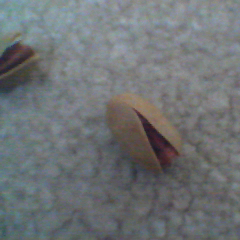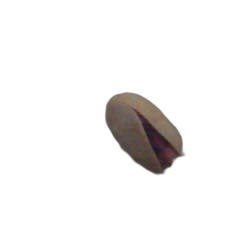This demo project locates "bad almonds" in camera images.
You need annotated images of good and bad almonds to create a dataset. A sample script is provided in the utility folder. It randomly selects good and bad almonds and places them in random locations in the background and generates the bounding box locations in csv files.
The following steps summarize the process:
1- Collect individual images of good and bad almonds with the original background removed and place them in the corresponding folders.
To remove the original background, you can use rembg package (https://pypi.org/project/rembg/):
2- Use create_dateset_almond.py script to generate the dataset:
Make sure to update the path to good and bad almonds and background, and adjust other parameters as needed:
# folder with good and bad almond pictures with no background
good_path = "almonds"
bad_path = "pistachio"
background_train = os.path.join("background_all")
background_test = os.path.join("background_all")
# number of good and bad objects per image
max_num_good_almonds = 3 # max number of good almonds in an image
max_num_bad_almonds = 3 # max number of bad almonds in an image
# size of dataset including training and test
total_size = 300003- Once completed, an "ALMOND" dataset folder is generated which includes train and test images and csv files with bounding box locations for each image. A zipped dataset file is also generated.
Currently, a limited set of plain dark and light background images is used to train the model.
A public background image repo with MIT license is here and may also be used: (https://github.com/JizhiziLi/GFM)
Install the training and synthesis tools as described in ai8x-training/README.md at develop · MaximIntegratedAI/ai8x-training (github.com)
The model, dataloader and scripts for this project are located in almond_detection_demo\train_synth_scripts. You can copy them over ai8x-training and ai8x_synthesis tools folders.
Also, copy the "ALMOND" dataset to ai8x-training/data.
Training:
(ai8x-training) $ ./scripts/train_almond_tinierssdface_168_224.shQuantization:
Make sure to update the quantize_almond_tinierssd_168_244.sh script with path to the checkpoint and the destination for the quantized checkpoint.
(ai8x-synthesis) $ ./scripts/quantize_almond_tinierssd_168_244.shEvaluation:
Make sure to update the path to the quantized checkpoint in the script.
(ai8x-training) $ ./scripts/evaluate_almond_tinierssdface_168_224.shSynthesis:
Make sure to update the path to the quantized checkpoint and the prefix with the project name in the script.
(ai8x-synthesis) $ ./gen-demos-almond-tinierssdface_168_224_SDK_Almond.shThe Known Answer Test (KAT) code will be generated in sdk/Examples/MAX78000/CNN
Copy the generated cnn.c, cnn.h, and weights.h from KAT project over almond_detection_demo/src and almond_detection_demo/inc.
Build and run on MAX78000FTHR:
$ make -r clean
$ make -r BOARD=FTHR_RevA
$ ./run.sh

